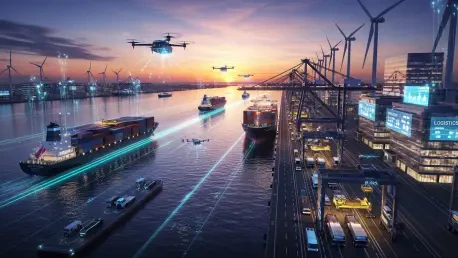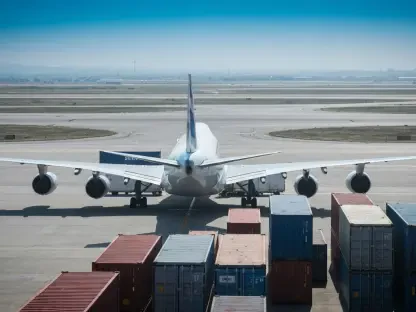Imagine a bustling port where containers move seamlessly without human intervention, where delays are predicted and prevented before they occur, and where energy consumption is optimized to reduce environmental impact. This is no longer a distant vision but a reality in many leading maritime hubs around the world, driven by the advent of smart ports technology. As global trade continues to grow, the pressure on ports to handle higher volumes with greater efficiency has never been more intense. This review delves into the transformative power of smart ports, exploring how digital tools and interconnected systems are revolutionizing maritime logistics under the Port 4.0 paradigm, and evaluates their features, performance, and potential to reshape the industry.
Understanding the Smart Ports Revolution and Port 4.0
Smart ports represent a fundamental shift in how maritime facilities operate, moving away from labor-intensive, manual processes to highly automated, data-driven ecosystems. At the heart of this transformation is the concept of Port 4.0, which aligns port operations with the principles of the fourth industrial revolution, emphasizing connectivity, automation, and real-time decision-making. By integrating advanced technologies, these ports aim to meet the escalating demands of international trade, where speed, accuracy, and sustainability are paramount.
This evolution is not merely about upgrading infrastructure but about creating a networked environment where every component—from cranes to containers—communicates seamlessly. The adoption of digital tools enables port authorities to monitor operations continuously, respond to disruptions instantly, and optimize resource use. Such capabilities position smart ports as critical nodes in global supply chains, ensuring that goods move faster and more reliably across borders.
The relevance of this shift extends beyond operational improvements, aligning with broader industry trends toward digitalization. As shipping companies and logistics providers demand greater transparency and efficiency, smart ports are becoming indispensable in maintaining competitiveness. This technological leap is setting a new standard for what ports can achieve in an increasingly interconnected world.
Core Technologies Powering Smart Ports
The backbone of smart port functionality lies in a suite of cutting-edge technologies that work in tandem to enhance performance. These tools are not standalone solutions but interconnected systems designed to address specific challenges in port operations. Their combined impact is reshaping how ports manage everything from cargo handling to environmental compliance.
Internet of Things (IoT) as the Connectivity Hub
Central to the smart port ecosystem is the Internet of Things, often described as the nervous system of modern port infrastructure. IoT enables the connection of countless devices, allowing for real-time data collection on container locations, equipment status, and environmental conditions. This connectivity ensures that port operators can track assets with precision, reducing the risk of loss or mismanagement.
Beyond tracking, IoT facilitates predictive maintenance by monitoring machinery for signs of wear and tear before breakdowns occur. Such proactive measures minimize downtime and extend the lifespan of critical equipment. Additionally, environmental sensors tied to IoT networks help ports monitor air and water quality, supporting compliance with stringent regulations and fostering sustainable practices.
The efficiency gains from IoT are substantial, as it allows for dynamic resource allocation based on live data. For instance, if a particular berth is underutilized, IoT systems can redirect incoming vessels to optimize space and reduce waiting times. This level of responsiveness is a game-changer in an industry where every minute counts.
Artificial Intelligence and Data-Driven Insights
Artificial Intelligence plays a pivotal role in transforming raw data into actionable insights for smart ports. Through predictive analytics, AI algorithms forecast cargo volumes, anticipate traffic congestion, and schedule maintenance, enabling ports to stay ahead of potential bottlenecks. This forward-looking approach significantly cuts down on delays and enhances throughput.
Moreover, AI optimizes decision-making by analyzing complex datasets that would be impossible to process manually. For example, machine learning models can determine the most efficient routes for container movement within a port, minimizing fuel consumption and operational costs. This precision not only boosts productivity but also contributes to greener operations.
The integration of AI extends to safety and security as well, with systems capable of detecting anomalies or potential hazards in real time. Surveillance powered by AI can identify unauthorized access or equipment malfunctions, ensuring a safer working environment. As these capabilities continue to evolve, AI is becoming an indispensable tool for port management.
Recent Innovations and Trends Shaping Smart Ports
The landscape of smart port technology is constantly evolving, with new advancements pushing the boundaries of what is possible. One notable development is the deployment of 5G networks, which provide ultra-fast communication essential for coordinating autonomous equipment and transmitting vast amounts of data without lag. This high-speed connectivity is proving vital for real-time operations in busy terminals.
Another emerging trend is the use of blockchain technology to secure documentation and streamline transactions. By creating tamper-proof records of cargo movements and customs processes, blockchain enhances transparency and reduces the risk of fraud. This innovation is particularly valuable in international trade, where trust and accuracy in paperwork are critical.
Sustainability is also a driving force behind recent trends, with ports adopting renewable energy sources and electric machinery to lower their carbon footprint. Additionally, augmented reality is gaining traction for training purposes, allowing workers to simulate complex tasks in a virtual environment. These developments reflect a broader shift toward efficiency and environmental responsibility in the maritime sector.
Real-World Applications and Performance Benefits
Smart port technologies are already delivering measurable results in major maritime hubs, demonstrating their value in practical settings. Ports equipped with automated systems report significant reductions in turnaround times for vessels, as cranes and vehicles operate with minimal human input. This speed translates to better integration with global supply chains, ensuring timely delivery of goods.
Cost savings are another key benefit, achieved through optimized operations and reduced energy consumption. Smart systems monitor power usage and adjust operations to avoid waste, while predictive maintenance prevents costly equipment failures. Such efficiencies allow ports to handle larger volumes without proportional increases in expenses, enhancing their economic viability.
Safety improvements are equally noteworthy, with automated processes minimizing human exposure to hazardous tasks. Sensors and AI-driven surveillance detect risks like spills or unauthorized activity, protecting both personnel and assets. These advancements collectively underscore the transformative impact of smart ports on logistics, setting a benchmark for operational excellence.
Challenges Hindering Smart Port Adoption
Despite the clear advantages, the implementation of smart port technologies faces significant hurdles that cannot be overlooked. Cybersecurity remains a pressing concern, as the increased connectivity of port systems creates vulnerabilities to cyberattacks. A single breach could disrupt operations or compromise sensitive data, posing risks to global trade networks.
Financial barriers also impede progress, particularly for smaller ports or those in developing regions. The high upfront costs of installing sensors, networks, and training programs can be prohibitive, even though long-term savings are substantial. This disparity risks creating a divide between technologically advanced ports and those unable to invest, affecting global competitiveness.
Efforts to address these challenges are underway, with enhanced security protocols being developed to safeguard digital infrastructure. Funding models, such as public-private partnerships, are also emerging to support technological upgrades. However, overcoming these obstacles requires coordinated action from industry stakeholders to ensure equitable access to the benefits of smart ports.
Future Directions for Smart Port Technology
Looking ahead, the trajectory of smart ports points to even greater levels of autonomy and innovation. Autonomous ships are on the horizon, promising to integrate seamlessly with smart port systems for fully automated cargo handling. Such developments could redefine efficiency standards, eliminating delays caused by human error or coordination issues.
Sustainability will continue to shape the future, with initiatives like hydrogen fuel infrastructure gaining momentum as a clean energy solution for port operations. Underwater drones are also being explored for maintenance tasks, offering a safer and more efficient way to inspect submerged structures. These advancements signal a shift toward eco-friendly and technologically sophisticated port ecosystems.
The long-term impact of these innovations extends beyond individual ports, influencing the broader maritime industry. As smart ports become more integrated with global trade networks, they are likely to drive standards for operational autonomy and environmental stewardship. This vision of interconnected, sustainable facilities represents the next frontier in maritime logistics.
Final Thoughts on Smart Ports Technology
Reflecting on this comprehensive evaluation, it is evident that smart ports technology has begun to redefine maritime logistics with remarkable advancements in efficiency, safety, and sustainability. The integration of tools like IoT and AI has proven instrumental in optimizing operations, while real-world applications demonstrate tangible benefits in cost reduction and supply chain coordination. Challenges such as cybersecurity risks and high investment costs pose significant barriers, yet ongoing efforts to address them show promise for wider adoption.
Moving forward, industry stakeholders should prioritize collaborative strategies to mitigate security vulnerabilities, perhaps by establishing global standards for digital protection in port operations. Investment in scalable solutions could help smaller ports adopt these technologies, ensuring that the benefits of smart ports are not limited to a few major hubs. Additionally, focusing on sustainable innovations like renewable energy integration should remain a key consideration, aligning port development with environmental goals. These steps could solidify the role of smart ports as indispensable pillars of modern trade, paving the way for a more connected and responsible maritime future.









